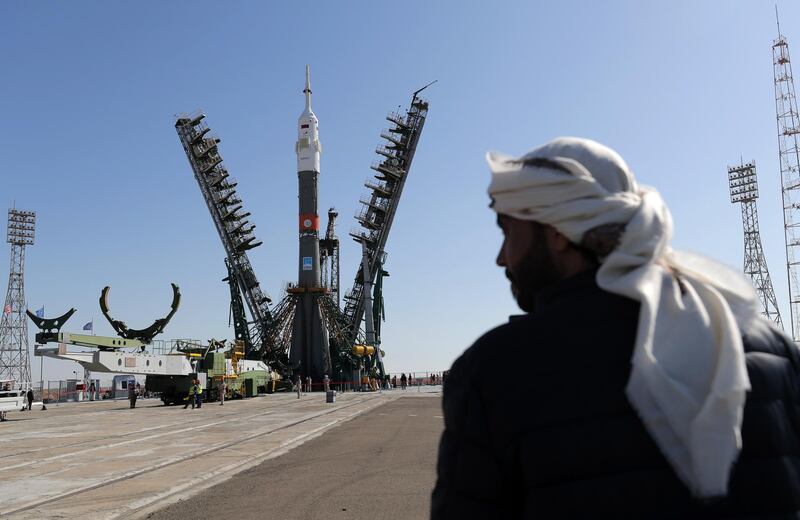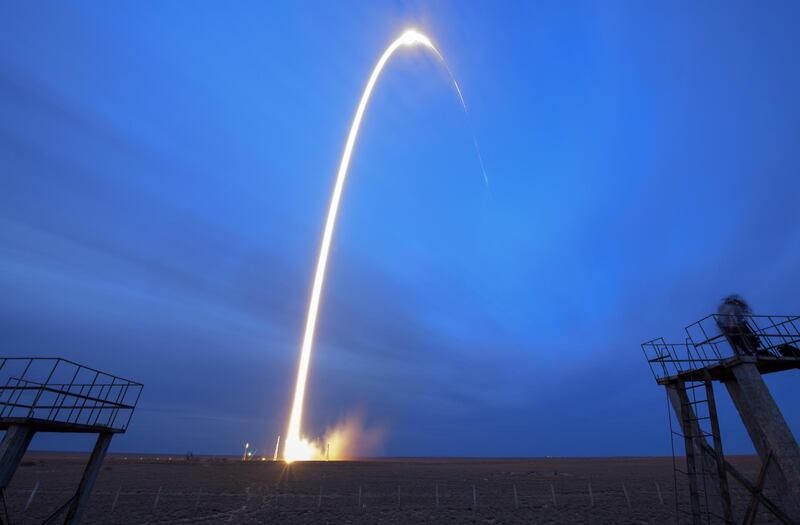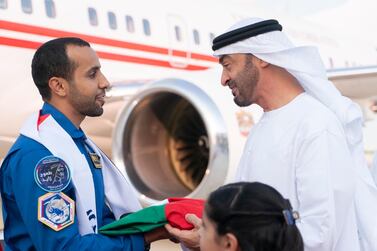It was early evening and dusk was already descending across the vast empty desert steppes of southern Kazakhstan.
Suddenly a brilliant flash of light illuminated the darkness, and seconds later a rolling wave of thunder that drowned all conversation.
All heads turned as a ball of fire and trailing smoke rose ever higher in the sky. Soyuz MS-15, carrying Maj Hazza Al Mansouri, the first Emirati astronaut, was on its way to the International Space Station.
It is a year since the beginning of that historic voyage into low Earth orbit. We have seen astronaut Maj Al Mansouri enjoying life on the ISS and celebrated his successful return home that October.
Photographs capture the achievements of a mission accomplished. But before the triumph there was also tension.
The first real sense of the courage needed for space travel came just 48 hours before launch, as two huge hanger doors rolled back and a train emerged from the assembly centre at Russia’s Baikonur Cosmodrome.
Rockets are typically described as huge, but the first impression of the Soyuz FG launcher as it rolled out in the early morning sunshine was how small it seemed for such a great adventure.
It emerged engines first, cradled sideways on specially designed rolling stock. Last into view was a small white cone. The crew capsule that was all of the 45 metre rocket that would return to Earth. For something so essential, it seemed almost like an afterthought.
For Maj Al Mansouri, the day began quarantined in the seclusion of the Cosmonaut Hotel and the last private moments with his family. Much is made of the courage of astronauts but it is a virtue equally shared by their loved ones, who can never show their fears but have them all the same.
By mid afternoon the three astronauts of MS-15 were in the final stages of preparation, enclosed in the flight suits that would protect them against the force of launch.
They emerged, bodies hunched by the suits’ design, but cheerful and smiling as they walked to the coach that would take them to the launch site. For the families there was once last glimpse and a chance to press hands separated by a pane of glass.
For the next three hours they would sit in their cramped capsule, on top of 40,000kg of highly volatile refined kerosine and liquid oxygen that was essentially a massive firework.
From the observation platform, just a kilometre away, the Soyuz rocket seemed even smaller when set against the endless Kazakh landscape. A Russian voice from mission control, broadcast the countdown over loudspeakers.
At exactly 5.57pm in the UAE, the engines ignited, a sideways flash of orange fire that ballooned outward and upward as the Soyuz began its ascent.
As it gained altitude, the noise became a fierce crackling of burning fuel. Passing through the clouds, the reflected fire illuminated the sky for a few seconds, then passed from view. Now 40 kilometres high, the last glimpse was four trails of smoke from the empty rocket boosters as they detached and fell back to earth.
Three minutes after launch came a moment of history, almost unnoticed at the time. At 100 kilometres above sea level, the Soyuz crossed the Karmen Line, the boundary between Earth and space. Maj Al Mansouri was now officially the first Emirati astronaut.
After nine minutes, the Soyuz was finally in orbit, the crew floating in zero gravity. Another six hours would pass before a successful docking with the International Space Station. Back on Earth, nervous anticipation could be replaced with celebration.


















